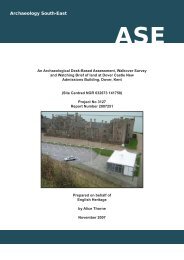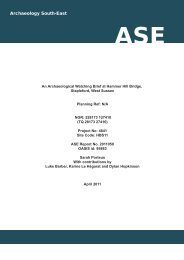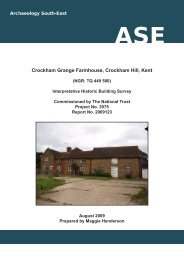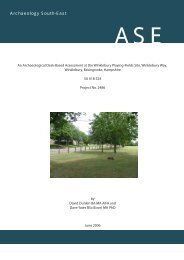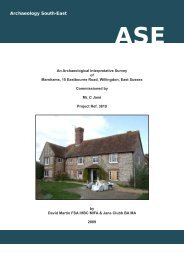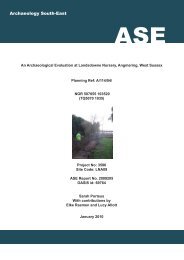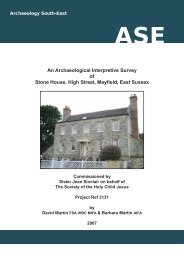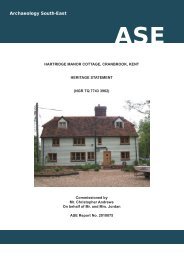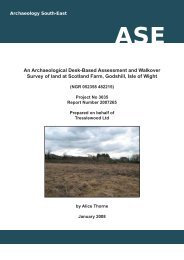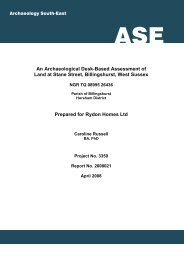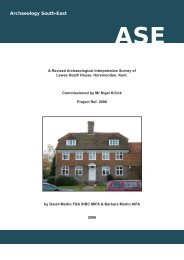ASE front cover - Archaeology South-East
ASE front cover - Archaeology South-East
ASE front cover - Archaeology South-East
Create successful ePaper yourself
Turn your PDF publications into a flip-book with our unique Google optimized e-Paper software.
<strong>Archaeology</strong> <strong>South</strong>-<strong>East</strong>2008058: Holbury Infants School, Holbury, Hampshireirregular base. This area had been badly disturbed by root damage and[1051] had diffuse edges. It was truncated on its western edge by probabletree throw [1050] (Figure 9, Section 16). Hearth/pit [1051] contained 9 fills:[1104], [1103], [1102], [1101], [1100], [1099], [1098], [1052] and [1123], thelatter probably the result of root disturbance within [1052]. The primary fill[1104] is interpreted as re-deposited natural and was a mid orangey brownslightly clayey sandy silt with occasional flint nodules and contained potterydating to AD 270 to the early/mid 4 th century and CBM. The secondary fill[1103] was a dark greyish brown silty sand with frequent burning andoccasional gravel inclusions, which produced pottery dating from AD 270 tothe early/mid 4 th century. The tertiary fill [1102] was a light brownish greysandy silt. The fourth fill [1101], interpreted as re-deposited natural, was amid orangey brown slightly clayish sandy silt with gravel inclusions [1101].The fifth fill [1100] was a light grey silty sand [1100]. The sixth fill [1099] wasa dark greyish brown silty sand with gravel inclusions and frequent flecks ofcharcoal [1099]. The seventh fill [1098] was a mixed greyish mid orangeybrown sandy silt with frequent lenses of re-deposited natural. The eighth fill[1052] was a mixed blackish dark brown and dark greyish brown sandy siltwith frequent flecks of charcoal and occasional gravel inclusions, whichcontained pottery dated to AD 300-360, Roman tegula and a piece of palegreen Roman glass [1052]. The ninth fill [1123] probably represents rootdisturbance within the fill, it was comprised of mixed re-deposited naturalproducing no artefacts.4.4.5 Hearth/pit [1051] was truncated on its westernmost edge by probable treethrow [1050], (Figure 9, Section 16), which also inter-cut hearth/pit [1057](Figure 9, Section 15) on its eastern edge. Probable tree throw [1050] waslocated in an area of heavy rooting; it was an irregular shape in plan withdiffuse edges. It was filled by a mid greyish brown slightly clayey sandy siltand contained pottery of AD 270-early/mid 4 th century date, CBM and metal[1049].4.5 Pits/postholes (Figure 9, Sections 12-14 inclusive)4.5.1 Pit [1047] (Figure 9, Section 14) was an irregular sub-oval shape in plan. Ithad an irregular elongated D-shaped profile and an irregular uneven base.The primary fill [1078] was a light yellowish brown silty clay with occasionalflint inclusions and containing pottery. The secondary fill [1048] was a midbrown sandy clay with occasional gravel inclusions and frequent flecks ofcharcoal which produced a small group of pottery dating to AD 270 to theearly/mid 4 th century.4.5.2 Pit or posthole [1045] (Figure 9, Section 13) was sub-oval in plan with abroadly U-shaped profile. The edges of the pit showed evidence of slightroot disturbance. It was filled by a dark brown silty clay with frequent flecksof charcoal but produced no artefacts [1046].4.5.3 Pit or posthole [1043] (Figure 9, Section 12) was sub-circular in plan with anirregular profile; the northern edge sloping gradually and the southern edgesloping more steeply and tapering inwards slightly towards the base. Theedges of the pit showed evidence of slight root disturbance. It was filled by amid brown silty clay with frequent burnt patches [1044]. One sherd ofabraded pottery dating to AD120-200+ was re<strong>cover</strong>ed along with Romanbrick, burnt clay and metal.12© <strong>Archaeology</strong> <strong>South</strong>-<strong>East</strong>



